#clinker built hull
Photo
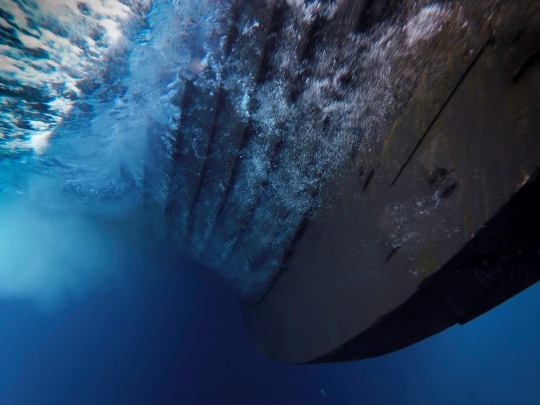
The hull of the Draken Harald Hårfagre, a viking longship replica. It seems to glide through the waves on bubbles. An effect that the hull creates due to its clinker construction and provides speed and buoyancy.
#naval history#naval artifacts#draken harald hårfagre#hull#clinker built hull#9th century#medieval seafaring#replica
112 notes
·
View notes
Photo

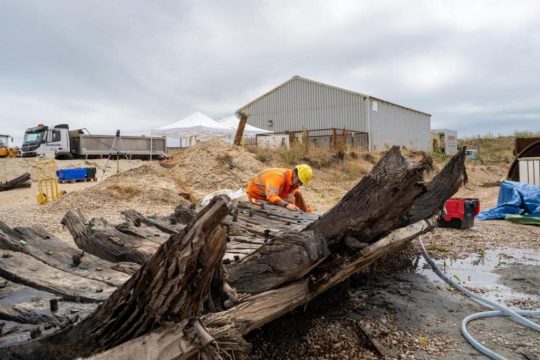

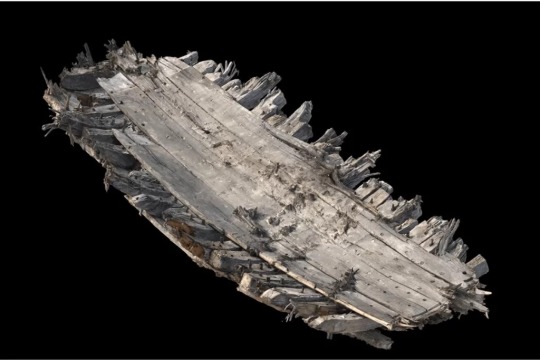

Rare Elizabethan Ship Discovered at a Quarry
An Elizabethan ship in “remarkable condition” has been discovered on the lake bed of a Kent quarry, one of only a few examples to survive from a pivotal period in England’s seafaring history.
In April, workers at a quarry on the Dungeness headland were dredging a lake when they came across the 16th-century timbers. As they pulled them up, the remains of the vessel’s hull came up in one piece, intact and undamaged by the movement.
Found some 300 meters from the coast, the discovery stumped the quarry team, who contacted archaeologists from Wessex Archaeology to study the remains. Recognising the significance of this extraordinary discovery, Kent County Council enlisted specialist support and emergency funding from Historic England.
What the archaeologists found is a rare Elizabethan ship, the timbers of which were cut between 1558 and 1580, during the reign of Queen Elizabeth I, according to a dendrochronological analysis.
Over 100 timbers from the ship’s hull were recovered, with dendrochronological analysis, funded by Historic England, dating the timbers that built the ship to between 1558 and 1580 and confirming it was made of English oak.
This places the ship at a transitional period in Northern European ship construction. When ships are believed to have moved from a traditional clinker construction (as seen in Viking vessels) to frame-first-built ships (as recorded here), where the internal framing is built first and flush-laid planking is later added to the frames to create a smooth outer hull. This technique is similar to what was used on the Mary Rose, built between 1509 and 1511, and the ships that would explore and settle along the Atlantic coastlines of the New World.
Andrea Hamel, Marine Archaeologist at Wessex Archaeology, said: “To find a late 16th-century ship preserved in the sediment of a quarry was an unexpected but very welcome find indeed. The ship has the potential to tell us so much about a period where we have little surviving evidence of shipbuilding but yet was such a great period of change in ship construction and seafaring.”
Although uncovered 300 meters from the sea in what is today a quarry, experts believe that the ship was either wrecked on the shingle headland or abandoned at the end of the ship’s usefulness.
Archaeologists have recorded the ship using laser scanning and digital photography. Once work is complete the timbers will be reburied in the quarry lake where they were uncovered so that the silt can continue to preserve the remains.
By Leman Altunta.
#Rare Elizabethan Ship Discovered at a Quarry#ancient ship#ancient shipwreck#ancient artifacts#archeology#archeolgst#history#history news#ancient history#ancient culture#ancient civilizations
42 notes
·
View notes
Text
How the fuck is a clinker built hull lighter than carvel construction. You need more fucking wood for the same area of hull.
This makes no sense at all.
12 notes
·
View notes
Photo

For his work in #BlackAtlantic, artist and co-curator @huthhayden combined a clinker-built boat hull exterior with a 🐋whale-like skeletal interior to create this empty vessel washed ashore titled “Gulf Stream.” Visit PublicArtFund.org/BlackAtlantic to learn about the connection between the work, an 1899 painting by Winslow Homer, and a Kerry James Marshall’s 2003 reinterpretation of that painting. image: Hugh Hayden, The Gulf Stream, 2022. Courtesy of the artist and Lisson Gallery. Photo: Nicholas Knight @nicholasknightstudio , Courtesy of Public Art Fund, NY The Gulf Stream was commissioned by Public Art Fund and presented as part of Black Atlantic at Brooklyn Bridge Park, New York City, May 17 – November 27, 2022 (at Brooklyn Bridge Park) https://www.instagram.com/p/ChpM550AjGq/?igshid=NGJjMDIxMWI=
4 notes
·
View notes
Text

This Moc cost around 70-75 euros in pieces!
Longships were a type of specialised Scandinavian warships that have a long history in Scandinavia, with their existence being archaeologically proven[1] and documented from at least the fourth century BC. Originally invented and used by the Norsemen (commonly known as the Vikings) for commerce, exploration, and warfare during the Viking Age, many of the longship's characteristics were adopted by other cultures , like Anglo-Saxons, and continued to influence shipbuilding for centuries.
The longship's design evolved over many centuries, and continuing up until the 6th century with clinker-built ships like Nydam and Kvalsund. The longship appeared in its complete form between the 9th and 13th centuries. The character and appearance of these ships have been reflected in Scandinavian boat-building traditions to the present day. The particular skills and methods employed in making longships are still used worldwide, often with modern adaptations. They were all made out of wood, with cloth sails (woven wool) and had several details and carvings on the hull.
The Sails can be done in any color, just need to shitch the technic pannels!
Sails inspired by the work of @albricks_workshop on instagram!
#legocustominstructions #legoinstructions #lego #legomoc #legomocs #moc #iinstructions #custom #legocustom #mocs #mocsmarket
0 notes
Text
“If early medieval Scandinavians had not become exquisite shipwrights, there would have been no Vikings and no Viking Age. They learned to build fast and flexible ships, oceangoing but also suitable for shallow river waters, that could transport large numbers of warriors. As a consequence, those parts of Europe that could be reached by the sea or navigable rivers bore the brunt of the Vikings’ fury.
The Scandinavians themselves were acutely aware of the importance of their ships, which they celebrated in their mythology, poetry, runic inscriptions, and funerary customs. A widespread belief circulated, for example, that the Afterworld was more appropriately reached by ship, so many a Scandinavian- Viking warrior as well as peaceful peasant - was buried in some kind of boat or at least accompanied by a symbolic ship.
...By around 900, Scandinavian shipwrights began to develop two different types of ships: long and sleek warships, on the one hand, and broad and comparatively short cargo ships, on the other. Scandinavian ships could reach impressive loading capacity, such as a twenty-five meter longship from around 1025 found in the harbor of Hedeby, which is estimated to have been capable to carry a load of 60 metric tons.
..Scandinavian shipwrights also built long and sleek ships that were used as warships. Such longships were provided with sails, but they also had places for sometimes dozens of rowers. A ship from 985 found in the harbor of Hedeby measures almost 31 meters by only 2.6 meters. It could be propelled by sixty rowers using thirty pairs of oars.
...The secret behind the excellence of Viking Age ships lies in how they were constructed. Centuries earlier, Scandinavian ships were constructed through the so-called clinker or lap-strake technique: the primary component of such a ship was the shell made from planks that had been placed side by side with a slight overlap, through which small clinching nails (‘clinkers’) hold the planks together. This makes the sides of the hull appear with small ‘steps’ between the planks. The technique produced a strong and flexible hull, which was stiffened by inserting frames and ribs to fix the shape firmly.
...In the Viking Age, the planks were not sawed but rather split from logs using wedges and axes. This meant that the planks followed the natural grain of the wood, making them more flexible and easier to bend than sawed planks. The best wood for boatbuilding was oak, strong and flexible, where it was available in southern Scandinavia. ...Pine was also used to build ships, perhaps especially in northern Scandinavia, where no oaks grew. The remains of Viking Age ships also include a few pieces of other kinds of woods, such as maple or birch.’
...Vikings ships’ square sails were their greatest liability. Such sails worked marvelously well as long as the wind blew in the direction they wanted to go. But when headwinds persisted, ships rigged with square sails were very poor at beating to windward, certainly when compared to modern sailboats with their triangular Bermuda rigs. In addition, oars were not of much use with a headwind of any strength.
...If one assumes that a master builder and ten shipbuilders worked on the original Skuldelev 2, it would have taken seven months to build the ship, assuming that they had access to plenty of low-skilled workers to fell and transport the necessary wood. That calculation includes only the woodworking. An additional 13,000 hours would have been required to forge the nails and other iron details, to burn the tar (from 18 cubic meters of pine wood), to make the ship ropes, and to weave and sew the sail (from linen or wool). In sum, a great many men and women worked some 40,000 hours to build this ship and equip it with all its fittings.”
- Anders Winroth, “Ships, Boats, and Ferries to the Afterlife.” in The Age of Vikings
10 notes
·
View notes
Text

VICTORIAN OAK 'SHIP' CRIB
LATE 19TH CENTURY
in the form of a boat with clinker built hull, carved with the name 'ALICE ELLEN' to the stern, mounted in a frame with a turned stretcher and grid panel base; with a later glass insert for use as an occasional table.
Lyon and Turnbull
13 notes
·
View notes
Quote
clinker-built : (nautical) Of a boat or ship: having the hull constructed using planks or plates laid so that each plank overlaps the edge of the plank or plate below it, and in the case of plates, behind it; the planks were traditionally secured by nails which had been clenched (or clinched), that is, after being hammered through the planks the points of the nails were bent to make them unremovable.
Today is European Maritime Day, which seeks to raise European citizens’ awareness of the seas and their importance.
https://en.wiktionary.org/wiki/clinker-built#English
1 note
·
View note
Text
VIKING DUBLIN: TRIAL PIECES
I
It could be a jaw-bone
or a rib or a portion cut
from something sturdier:
anyhow, a smaller outline
was incised, a cage
or trellis to conjure in.
Like a child's tongue
following the toils
of his calligraphy,
like an eel swallowed
in a basket of eels,
the line amazes itself
eluding the hand
that fed it,
a bill in flight,
a swimming nostril.
II
There are trial pieces,
the craft's mystery
improvised on bone:
foliage, bestiaries,
interlacings elaborate
as the netted routes
of ancestry and trade.
That have to be
magnified on display
so that the nostril
is a migrant prow
sniffing the Liffey,
swanning it up to the ford,
dissembling itself
in antler combs, bone pins,
coins, weights, scale-pans.
III
Like a long sword
sheathed in its moisting
burial clays,
the keel stuck fast
in the slip of the bank,
its clinker-built hull
spined and plosive
as Dublin.
And now we reach in
for shards of the vertebrae,
the ribs of hurdle,
the mother-wet caches--
and for this trial piece
incised by a child,
a longship, a buoyant
migrant line.
IV
That enters my longhand,
turns cursive, unscarfing
a zoomorphic wake,
a worm of thought
I follow into the mud.
I am Hamlet the Dane,
skull-handler, parablist,
smeller of rot
in the state, infused
with its poisons,
pinioned by ghosts
and affections,
murders and pieties,
coming to consciousness
by jumping in graves,
dithering, blathering.
V
Come fly with me,
come sniff the wind
with the expertise
of the Vikings--
neighborly, scoretaking
killers, haggers
and hagglers, gombeen-men,
hoarders of grudge and gain.
With a butcher's aplomb
they spread out your lungs
and made you warm wings
for your shoulders.
Old fathers, be with us.
Old cunning assessors
of feuds and of sites
for ambush or town.
VI
'Did you ever hear tell,'
said Jimmy Farrell,
'of the skulls they have
in the city of Dublin?
White skulls and black skulls
and yellow skulls, and some
with full teeth, and some
haven't only but one,'
and compounded history
in the pan of 'an old Dane,
maybe, was drowned
in the Flood.'
My words lick around
cobbled quays, go hunting
lightly as pampooties
over the skull-capped ground.
--Seamus Heaney,
from North, 1975.
0 notes
Quote
Viking boats were the result of a long Scandinavian ship-building tradition, which saw the development of a variety of specialized warships and commercial craft. Archaeologists can trace Scandinavian boat-building back to the Bronze Age...In contrast to ships of Mediterranean construction, Northmen built their vessels from the outside inward. First they formed a flexible outer hull of overlapping planks held together with iron rivets. Then into this 'clinker'-built hull, they inserted the ship's rigid internal wooden skeleton. Built with this clinker method, the hull was both flexible and strong, an innovative combination suitable for the rough seas of the North Atlantic. With their single mast and square sail, Norse vessels were swift. When the sail was down, the boats were easily rowed.
Designed with a shallow draft, Scandinavian ships offered exceptional mobility, and they could be beached without harbours. This feature allowed Norse seafarers, whether in war, commerce or exploration, to sail a wide variety of ocean and inland waterways. Vikings tended to attack when and where they detected weakness. Speed at landing their ships and then withdrawing increased the terror of Norse raiders. If they miscalculated, and the defences of those attacked proved too strong, Vikings returned to their ships and sailed off in search of weaker prey.
Viking Language I: Learn Old Norse, Runes, and Icelandic Sagas
2 notes
·
View notes
Text
The Mortar Wreck
In 2020, archaeologists found a wreck in Swash Channel, near Poole Bay in Dorset, England, believed to be Britain's oldest known wreck with wooden remains in English waters.
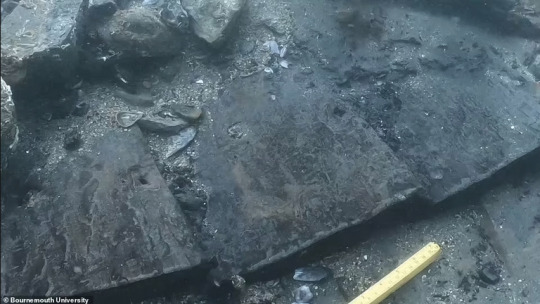
The clinker construction of the hull. The wood used here is Irish oak from the 13th century.(x)
The clinker-built remains have been dated to between 1242-1265 thanks to dendrochronology.
The survival of 13th-century vessels is extremely rare, and prior to this discovery, there are no known wrecks of seagoing ships from the 11th to the 14th century in English waters. There are older wrecks dating back to the Bronze Age in English waters but these only comprise the remains of the cargo and no hull structure remains. Here, too, cargo has been preserved.

Parts of the cargo (x)
The presumably 20m long cargo ship, which probably fell victim to a storm, carried mortars, stone kettles, Gothic Purbeck stone gravestones and raw marble from the nearby Isle of Purbeck, as well as a large kettle for cooking soup, a smaller kettle with a long handle and cups covered in concretions, hence the name Mortar Wreck. The finds are now being cleaned and prepared for display at Poole Museum.
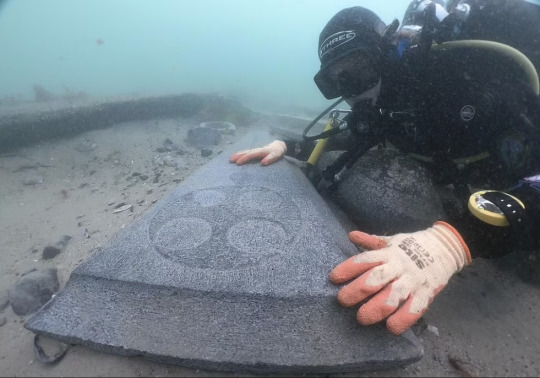
One of the Purbeck Stone gravestones (x)
The wreck itself has now been given protected heritage status, but whether it will ever be lifted is unclear.
#naval history#shipwreck#mortar wreck#13th century#cargo vessel#clinker built hull#medieval seafaring
106 notes
·
View notes